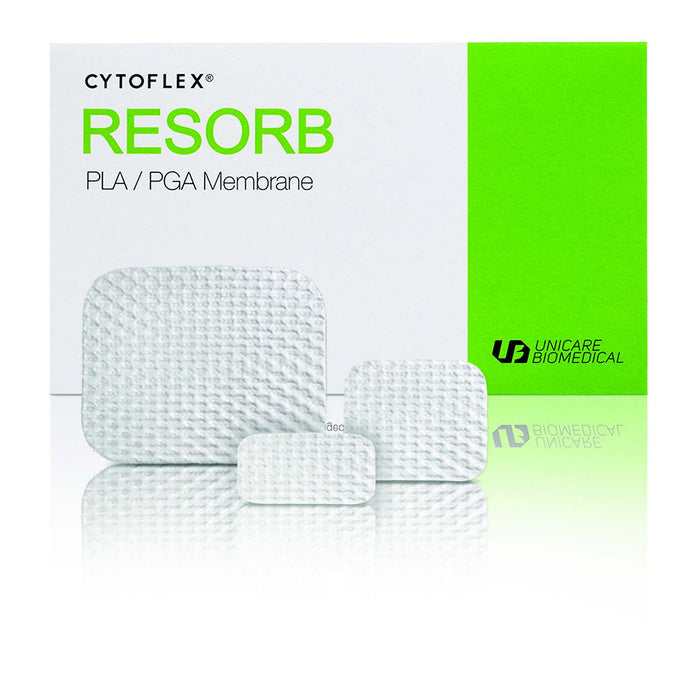
Cytoflex® Resorb Synthetic Barrier Membrane - 20x25mm, 1 per pack
Cytoflex® Resorb is a synthetic, microporous resorbable barrier membrane. Cytoflex® Resorb membranes are designed to enhance the adhesion of host cells, and at the same time provide a favorable environment for neo-vascularization and repopulation of bone cells to regenerate osseous tissue. The flexible barrier membranes are easily adaptable to tissue contours, yet offer sufficient duration to protect the bony defect from the intrusion of bacteria and soft tissue. Composed of synthetic polylactide and polyglycolide copolymers, Cytoflex® Resorb barriers are resorbable and do not require a second retrieval procedure.
Cytoflex® Resorb Product Benefits
- Completely resorbable
- Over 2-month barrier function
- Non-pyrogenic, non-immunogenic
- High nutrient permeability
- High dimensional stability
Brochure
FAQ
What is Cytoflex® Resorb membrane made of?
Cytoflex® Resorb membrane is made of biodegradable polyglycolide, polylactide and lactide /glycolide copolymers. These polymers are biocompatible and used in many implant devices, including resorbable sutures and bone fixation screws. Cytoflex® Resorb breaks down first by hydrolysis, then by metabolic processes, eventually turning into water and carbon dioxide.
Is Cytoflex® Resorb chemically similar to the membrane used in the Box technique (for vertical and horizontal ridge augmentation)?
Cytoflex® Resorb is chemically similar to the materials used in the Box technique, however, Cytoflex® Resorb is thinner and more flexible than the material used in the Box technique. The Box Technique was invented in November 2008 by Dr. Andrea Menoni; it is the first prosthetically guided bone regeneration technique aimed at fully restoring the lost bone volume by using resorbable polylactide materials.
What are the indications of Cytoflex® Resorb?
Cytoflex® Resorb was cleared by the FDA for use as a space making barrier in the treatment of periodontal defects, including two or three wall bone defects, class II furcations, recession type defects, circumferential defects, and dehiscence defects associated with dental implants.
How long is Cytoflex® Resorb membrane implanted for?
Cytoflex® Resorb is absorbable and does not need to be removed. The membrane is a long lasting membrane with a barrier function of over 2 months and is completely absorbed by the body within 6 months.
Which side of Cytoflex® Resorb should face gingival tissue?
The surface with the distinct diamond pattern embossing (large grating) should face the gingival tissue. The smoother surface should face the bony defect or bone graft site. NOTE: In the inner package, the embossed layer faces the dentist.
How stiff is the Cytoflex Resorb material?
Cytoflex Resorb is slightly stiffer than regular paper yet can be easily folded without any pre-soaking.
Can Cytoflex® Resorb be trimmed to fit a variety of defect sizes?
The membrane may be cut to the desired configuration with scissors. To enhance stability and adequate protection of the space over the bony defect, the membrane should be trimmed to extend 2-3mm beyond the defect margins and to remain at least 1 mm from adjacent, uninvolved teeth.
May screws or tacks be used to stabilize Cytoflex® Resorb membranes?
Cytoflex® Resorb can be fixated with surgical screws or tacks. Proper fixation may be used to prevent membrane perforation and/or early exposure.
Is soaking required prior to administration?
Cytoflex® Resorb can be trimmed, shaped and administered without pre-soaking. Doctors may wet the membrane either with sterile saline or patient’s blood prior to administration.
What are the recommended closure techniques?
In general, a double layer closure, with a deep layer of horizontal mattress suture followed by a standard wound closure with interrupted suture is recommended. During primary closure, adequate flap release must be accomplished in order to achieve a tension-free closure. Closure should be maintained for at least two weeks after surgery. The use of long lasting monofilament suture is recommended to prevent premature loss of suture strength, which may lead to early membrane exposure during the initial 2-week healing period.
Does the Cytoflex Resorb require primary closure? Can it be left exposed?
Cytoflex Resorb is cleared for use in conjunction with primary closure. No clinical studies have been performed as if the membrane can be left exposed.
Can unused portions of Cytoflex® Resorb membrane be re-sterilized and re-used?
No, Cytoflex® Resorb membranes are designed for single use only.
What is the shelf life of Cytoflex® Resorb membranes?
Cytoflex® Resorb has a shelf life of 3-years from the date of manufacture.
Have you ever had a confirmed allergic reaction to Cytoflex® Resorb membranes?
There has been no reported allergic reaction caused by Cytoflex® Resorb membranes.
Are there any contraindications to the use of Cytoflex® Resorb?
Cytoflex® Resorb membrane should not be used for load bearing applications or for patients where general oral surgery is not advisable. Patients with the following defects cannot expect optimum wound healing with GTR surgery.
- Extremely severe defect with little or no periodontium.
- Defects that preclude making adequate spaces such as horizontal defects.
- Flap perforations or compromised flap preparations have occurred during surgery.
- Multiple tooth procedures in which more than two pieces of Cytoflex® Resorb membranes are implanted next to each other.
WARNING: No clinical data on treating the following patients with Cytoflex® Resorb has been collected. Consult with the patient's physician prior to treatment.
- Pregnant women, patients with an artificial heart valve or any other artificial prosthetic device, immuno-compromised patients (diabetes, chemotherapy, irradiation and HIV infection), and patients with a history of connective tissue disease or steroid use either at the time of treatment or for one year period prior to treatment.







